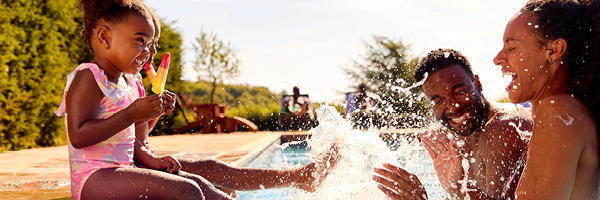Pool maintenance and safety tips
Posted in General, Home

Although a pool can provide family fun, it also can cause a safety risk or death. Drowning is the second leading cause of death for children 1-14 years old, according to the Centers for Disease Control and Prevention, and an extensive study performed by the Consumer Product Safety Commission (CPSC) found that "75 percent of the children involved in swimming pool submersion or drowning accidents were between 1 and 3 years old." Pools are meant to be enjoyed, so take these steps to keep them safe and fun.
Child and Swim Safety
- Never leave your child unsupervised and avoid any distractions that take your attention away from them. Such as phones, reading materials, etc.
- Teach your children how to read depth markers and what depth of water is safe for their height
- For babies, toddlers and young children, make sure to always be hands-on and close by for assistance; small children and weak swimmers should always wear a life jacket
- Designate a swim break every 30 min to rest and recharge
- Explain to your child the difference between good and bad decisions in the water. For example, do not dive head-first, instead jump in feet-first
- Give your child safety briefings before every swim so they are properly prepared to safely swim
Pool Maintenance
- Clean pool drains often to ensure proper function
- Drain any inflatable/temporary pool to maintain cleanliness and eliminate any risk of drowning
- Skim water surface weekly to collect any unwanted bugs, twigs, leaves, etc.
- Check water levels often to ensure any filters and skimmer doors (help keep debris out) operate properly
- Ensure chemical ratios are at proper levels to keep swimmers safe. Water should never be cloudy, and swimmers should always be visible from above the water

Learn about our
Home Insurance
Safety Precautions
- Install a self-closing and locking safety gate that is at least 4 feet high to keep young children from entering the pool area when they are unsupervised.
- Consider purchasing a Safety Vacuum Release System, which disables a pool pump’s suction ability so that a body or trapped object against the suction outlet is free.
- It is important to have anti-entrapment drain covers to prevent hair, swimsuits, etc. from becoming tangled in the draining system.
- One of the easiest and least expensive ways to prevent a child from being injured—or worse, drowning—is a pool alarm. Pool alarms may be on windows and doors leading to your pool area, the surface of your pool water, submerged in your pool or on a person’s wrist.
- Purchase a mesh or solid safety cover to protect children or animals from drowning or becoming submerged. Solar pool covers and winter pool covers are not safety covers.
- Knowing CPR and acting immediately can make the difference between life and death in drowning cases or anytime a person's heart stops while swimming
- Have proper lifesaving equipment, like a first aid kit, life hook and swimming pool rescue tube close in case someone is injured
- Make sure a slide or diving board meets regulation standards
- Remove any steps/ladders from the pool while unattended
If you are installing a new pool or have a pool, contact your independent insurance agent to ensure that it is properly covered under your home insurance policy and all safety regulations and requirements are met.
Disclaimer: This article is for informational and suggestion purposes only. Implementing one or more of these suggestions does not guarantee coverage. If any policy coverage descriptions in this article conflict with the language in the policy, the language in the policy applies. For full details on Integrity’s home insurance coverages and discounts, contact your local, independent Integrity insurance agent.
Related resources